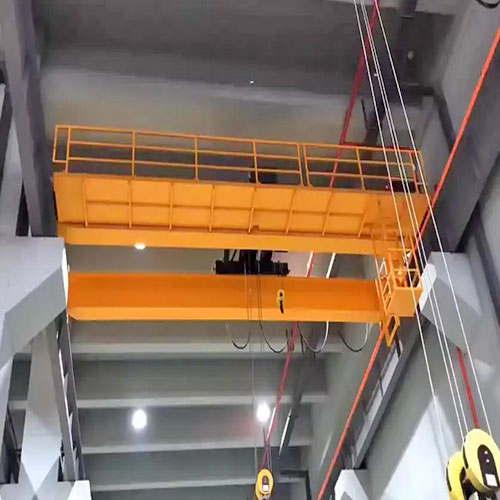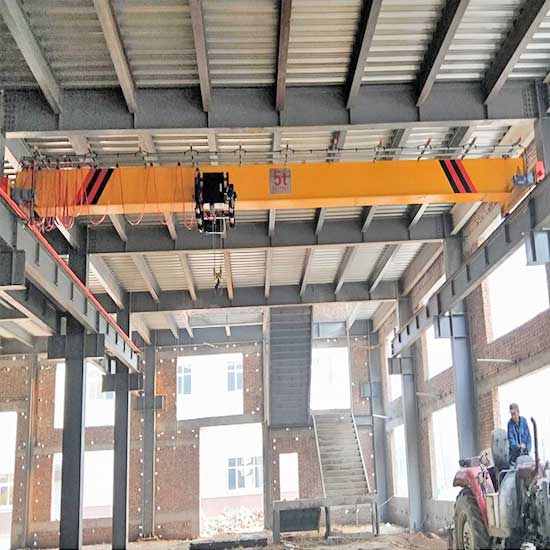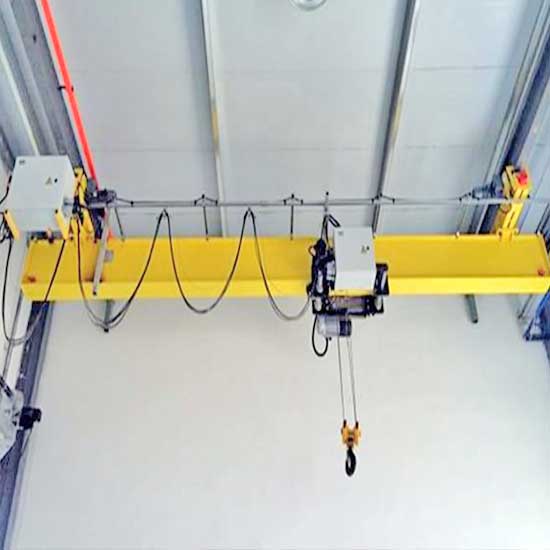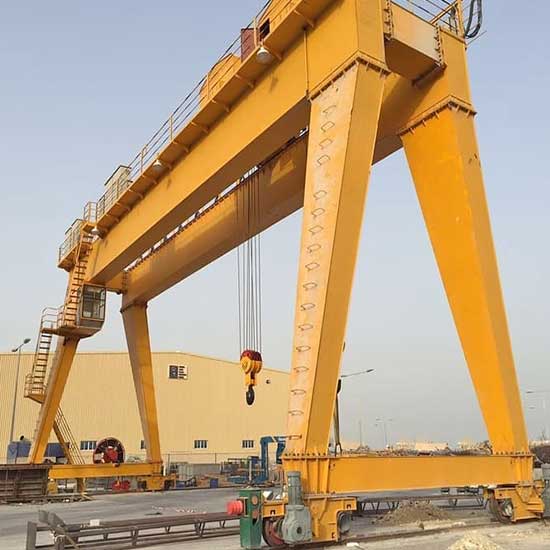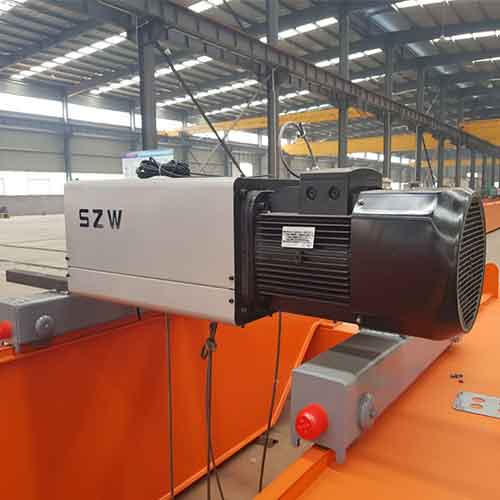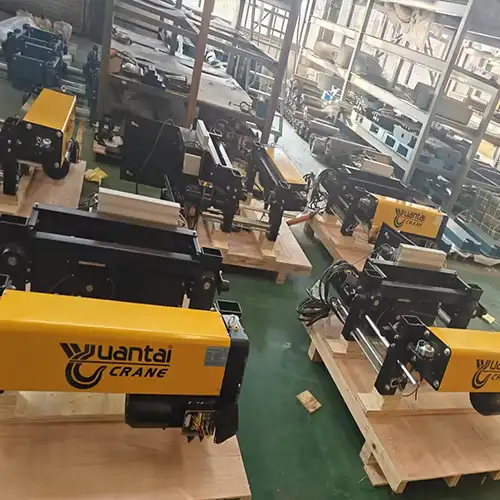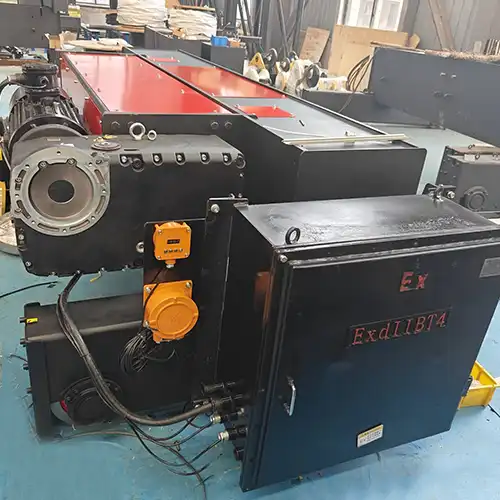VFD Control Cranes and Hoists & Variable Frequency Drives
Advanced VFD crane & hoist control,Advanced Crane & Hoist system to ensure greater speed adjustments precise load position, longer hoist life. Check now.
| Crane type | European style crane, equipped with vfd control |
| Crane capacity | 1 ton -320 ton |
| Lifting Height | Customized as your request |
| Crane Span | As customer requirement |
Category: Overhead Crane for Your Use
Your Trusted Overhead Crane Manufacturer & Supplier
VFD Control Cranes and Hoists & Variable Frequency Drives
Advanced Electric Overhead Crane & Hoist Control System
Advanced VFD crane & hoist control,Advanced Crane & Hoist system to ensure greater speed adjustments precise load position, longer hoist life. Check now.
Types of Variable Frequency Drive hoist and overhead crane systems, which are usually designed with European overhead crane style, are provided to enable your material handling more efficient and precise. What exactly is variable frequency drive control? Variable frequency drives are a type of AC motor controller that uses frequency and voltage to drive an electric motor, allowing for precise speed, energy efficiency, and digital diagnostics. Variable frequency drives, also known as VFDs, adjustable speed drives, or AC drives, are a type of variable frequency drive. Our VFDs can be installed in either a 230 volt or a 460 volt AC environment. There are also AC regenerative drive and DC voltage drive options. In select markets, we can also custom engineer specialty crane drives for unique applications, as well as provide on-site diagnostic services for hoist and crane drives.
Main technical characteristics of crane frequency drive
Adopt advanced modern AC frequency conversion speed regulation and programmable control technology to carry out technological transformation on all electric drive systems of traditional gantry crane and bridge cranes, so as to achieve stable operation of goliath crane and overhead bridge cranes, improve operating power, and improve overload operations.Optimal material handling operation can be achieved by eliminating the braking impact, reducing electrical protection, reducing power consumption, and improving power loss factor. At the same time, the VFD crane system system also has over-current, over-voltage, under-voltage and input phase loss protection, as well as inverter over-temperature, overload, over-speed, brake unit overheat, and motor fault protection. As for your custom overhead crane system, these features can be added according your particular needs and lifting requirements. Contact our crane engineer to get your custom vfd crane design!
VFD control overhead crane & hoists
Why to select our VFD control crane & Hoist?
- Advanced design concept - An electric overhead crane manufacturer that breaks the design concept of the hoisting mechanism of the crane and applies the planetary gear reducer to the hoisting mechanism. The hoisting mechanism adopts a direct connection link, which combines the motor, reducer and brake. It effectively improves the transmission efficiency, minimizes all kinds of transmission parts required by the lifting mechanism, reduces noise, and at the same time, the mechanism has independent intellectual property rights.
- Frequency conversion control to whole hoist and crane system -for all kinds of European standard single and double girder cranes, our company adopts Variable Frequency Driver for all of the hoist and crane travelling system,. At the same time, automation and intelligent crane can be developed to realize the unmanned operation, remote monitoring, and anti-sway function.
- Low noise, low energy consumption - low noise, maintenance-free (reduced maintenance time and low maintenance cost) (due to the simple structure, there are fewer types of supporting parts or by-pass parts , which is convenient for later procurement and also reduces inventory). Our company's European style fem standard cranes are adjusted by frequency converters, which can effectively reduce power consumption by 20%-30%, reduce use costs, and improve use efficiency.
What is a Variable Frequency Drive Used For?
After the development of low cost, high speed power transistors, variable frequency drives, or VFDs, were introduced to the material handling sector in the late 1980s and early 1990s. For better precision and control over single-speed and two-speed motors, variable frequency drives were developed. Today, they are utilized to regulate every motorized movement on an overhead crane, including the hoist, bridge, trolley, and in some circumstances, the rotation of hook.
A VFD generates a sinusoidal wave to change the frequency of an AC motor, as the name suggests. An AC motor is "tricked" into believing it is operating at synchronous speed even if it is not by the drive by altering the voltage and frequency provided to the motor. This results in improved and more fluid motor controls, as well as changeable speed controls and ramps for acceleration and deceleration.
These VFD systems have become more and more popular as their price has decreased, and they are now specified in many different types of crane systems, from lower-duty package crane systems to high capacity/high duty cycle process cranes.
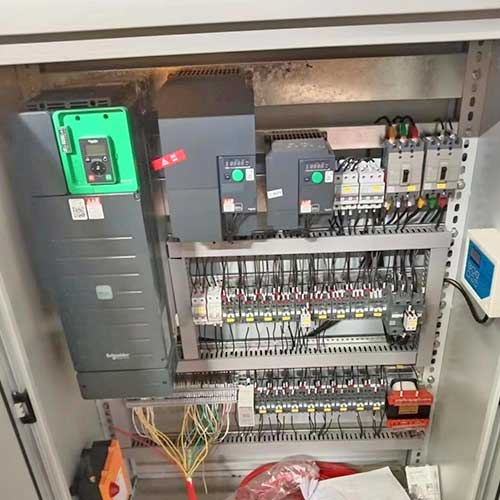
Overhead crane with Variable Frequency Drive Control
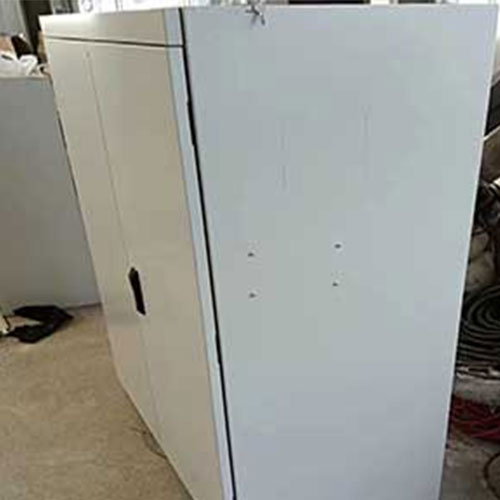
VFD electric box
VFD Control For Cranes And Hoists VS. 2-Speed Controls
Before variable frequency drives, overhead crane operators used contactor-based controls to control their cranes. The electric crane systems were equipped with either a single-speed or a two-speed motor for lower duty cycle cranes. They used what was known as a wound rotor motor for higher duty cycle cranes.
Single-Speed or 2-Speed Motors
Depending on the load, a single speed motor accelerates as quickly as it can when the operator pushes a button. The crane stops and the brakes apply as soon as the button is released. So, if your crane has a motor that runs at 50 fpm (feet per minute), that is the only speed it can work at.
The crane can run at two different speeds on a two-speed motor, usually within a 3:1 ratio. So, if the crane has a two-speed motor, it can operate at 40 fpm or 120 fpm, but no other speeds are available.
The "Soft Start" technology, also referred to as a Reduced Voltage Starter, can be used with these applications with lower duty cycles. This technology reduces voltage to the motor, resulting in less acceleration at startup and less torque applied to the overhead crane's drivetrain during acceleration. It is not advised to use this control method on cranes with high usage or high duty cycles because it can quickly cause the motors to overheat.
Comparison of VFD & Double Speed Motors
There are two types of controls available for cranes and hoists. The variable frequency controls and the two-speed controls are the two controls. When comparing 2-speed controls to Variable frequency drives, or VFD control for your cranes and hoists, there are several factors to consider. These variables can range from speed adjustments to load control to the length and efficiency of the hoist's life. In the following, the advantages of two-speed controls over variable frequency drive control.
Let's see how 2-speed and variable frequency drive controls react to certain factors. Some of the characteristics can assist in comparing and contrasting the differences between two-speed controls and variable frequency drive controls.
Variable frequency drive controls: | 2-speed controls: |
For greater speed adjustments | |
VFD for crane application - The user can select from a variety of speed settings using the controls for the variable frequency drive. But it expands the possibilities for customisation. Consequently, you can select your speed settings based on your application. | 2-speed controls: The speed can be adjusted with a 2-speed control. These two speeds, however, are provided by the motor manufacturer. It would be impossible to change it. |
On brakes | |
VFD crane control: The VFD for crane application can use dynamic braking to gradually slow the crane. The motor in this control regenerates braking energy into the controls, which facilitates in heat dissipation via resistors. It is also recycled. The brake mechanism, however, can only be used for emergency and parking stops with the help of variable frequency drive controls. It significantly increases the life of your electric overhead crane's braking system. | Two-speed controls: One calls for a brake system to slow the electric hoists. It can be one of the factors contributing to ongoing wear and tear. As a result, maintenance costs go up or brakes need to be replaced more frequently. Uncontrolled and abrupt braking can also result in severe load swinging. |
On efficiency | |
VFD crane control: When using variable frequency drive controllers, power is only consumed when the motor requires it. Compared to contractors or soft starters, it uses a lot less energy. | 2-speed controls: Speed resistors, however, determine how much energy 2-speed controls use, and the control system continuously wastes this energy. |
On improving load control | |
Controlled by a variable frequency drive, this system keeps everything running smoothly while gradually reducing the load. By functioning in traverse motion with smoother acceleration, the VFD load control reduces the load swing. | Two-speed controls: It is challenging to position a load precisely when the operator is trapped in two-speed control. The load swing and the shock loading are impacted by the severely constrained speed control in this situation. However, if you attempt to keep the hoist in a specific position, the weight results in a high rush contact, which raises the temperature. The hoists' lifespan is shortened by it. |
Increased hoist life | |
VFD for hoist application: Some Variable frequency device controls protect the the overhead crane hoists motor from overcurrent and thermal overload. As a result, the motor's life is extended, as are the life of the windings and insulation. Sometimes the variable frequency device control utilises a ramp-to-stop braking system to reduce force. It only happens in emergencies and parking situations. | 2. Speed controls: You should intensify the process of cleaning and maintaining the speed registers and breaks, respectively, as you start to employ speed controls. The motor's lifespan is consequently shortened. |
In the case of regenerative energy | |
VFD for crane application: Lowering or decelerating the crane's hoist may result in regenerative energy. This energy, however, is generated by the motor's operation. The energy, on the other hand, is converted into heat by a braking resistor. It can also be conditioned and returned to its original source, which helps to save energy. With the help of a braking resistor, the controller redistributes the portion of energy that is converted into heat without wasting it. | 2-speed controls: In the case of a two-speed control, the brake shoes or the speed registers are used to disperse the regenerative energy. Here, all of the energy is transformed into heat and ultimately lost. |
In the case of digital diagnostics | |
Variable frequency drive controls: You can choose digital diagnostics, nevertheless, with the help of a variable frequency drive control. However, it helps in maintaining and troubleshooting the machinery. | 2-speed controls: If 2-speed controls were available, no diagnostic data would be recorded or kept. |
What are the advantages of using VFD crane control & hoist control?
The fact that variable frequency drive controls may be applied to virtually any crane application is one of the biggest advantages of updating your overhead crane with them.
1. Programmable Speed and Control Parameters
High-end VFD systems allow up to 200–300 programmable control parameters for the bridge, trolley, hoist, and hook. This flexibility lets operators set multiple speed points and smooth acceleration/deceleration, improving operational precision and reducing mechanical stress.
2. Reduced Wear on Brakes
VFDs allow cranes to decelerate smoothly after the control button is released, using the brakes primarily as parking brakes. This controlled stopping drastically reduces brake wear, extending service life and lowering downtime.
3. Adjustable Acceleration and Deceleration Times
Sudden starts and stops can stress internal components like couplings, gearboxes, wheels, runway beams, and wire ropes. VFDs let operators precisely control acceleration and deceleration, minimizing wear and reducing load swing.
4. Precise Load Positioning
The bridge, trolley, and hoist can be set to run at any speed within a wide ratio, allowing careful movement for fragile or precise loads. Operators can slow down to a fraction of top speed for fine positioning without compromising safety or efficiency.
5. Load Limiting and Torque Restriction
VFDs can be programmed to stop lifting if the load exceeds a preset limit, providing mechanical protection without additional load cells. Torque restrictions prevent overtaxing the motor, reducing mechanical wear and enhancing safety.
6. Fault Codes and Diagnostics
Operators, maintenance staff, and even remote technicians can monitor, configure, and troubleshoot VFD systems using diagnostic software. Alerts and fault codes allow issues to be resolved quickly, often without needing physical access to the crane. Periodic and preventative maintenance alerts can also be configured based on crane usage.
7. Extended Hoist Life and Operational Benefits
Advanced VFD crane and hoist control ensures smoother operation, precise speed adjustments, reduced mechanical wear, and longer hoist life. These benefits translate into lower maintenance costs, improved safety, and more efficient operation.
If you have any questions or need VFD-controlled overhead crane and hoist solutions, please feel free to contact us.
Related Products
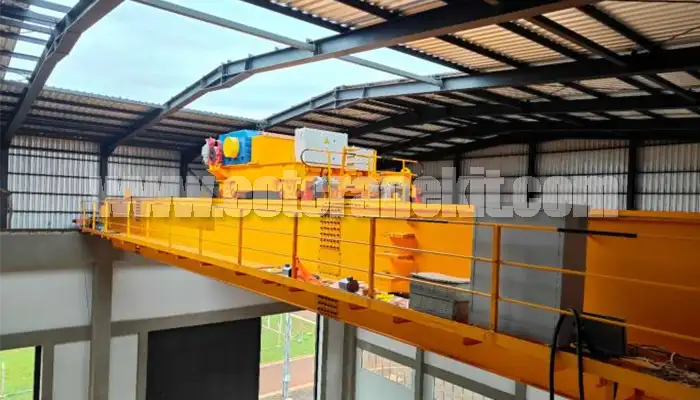
Latest project
150 Ton Overhead Crane Installation Feedback – Paraguay Case
QDX 150 ton overhead crane in action in Paraguay. Installation photos, video, and client feedback show performance, safety, and heavy-lifting efficiency.
Free consultation to Confirm Parameters & Specifications and Get
Latest Crane Price & Crane Rate.
- Types of overhead cranes : _______?
- Optional: Overhead travelling crane, goliath gantry crane,Slewing jib crane, Single girder or double girder crane,small portable crane or kbk crane, etc.
- Capacity of overhead crane: _______?
- Optional: 0.25ton, 0.5 ton, 1 ton, 2 ton, 3ton, 5 ton, 10 ton,15ton, 20ton, 25 ton, 30ton,35ton, up to 550ton, etc.
- Crane span & lifting height : _______?
- Crane travelling length : _____?
- Control of overhead crane:_______?
- Optional: pendant/ remote/cabin control
- Voltage supply of overhead crane:_____?
- Eg,: 380V50/60HZ,3Phase or others,etc.
- Application/usage of crane:_______?
- Eg,: Steel mill, ,injection mold, cement,stone, concrete,granite, general manufacturing, etc.
Just leave a message via the contact form and our hoist and crane engineer will contact you with in 24working hours.
Get In Touch
